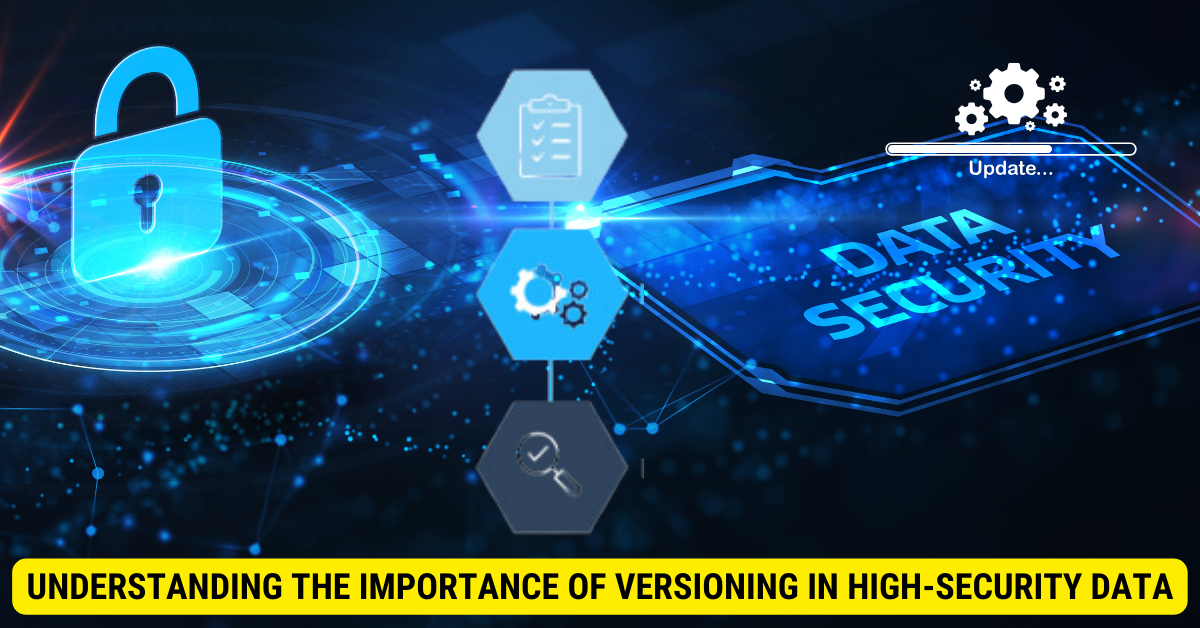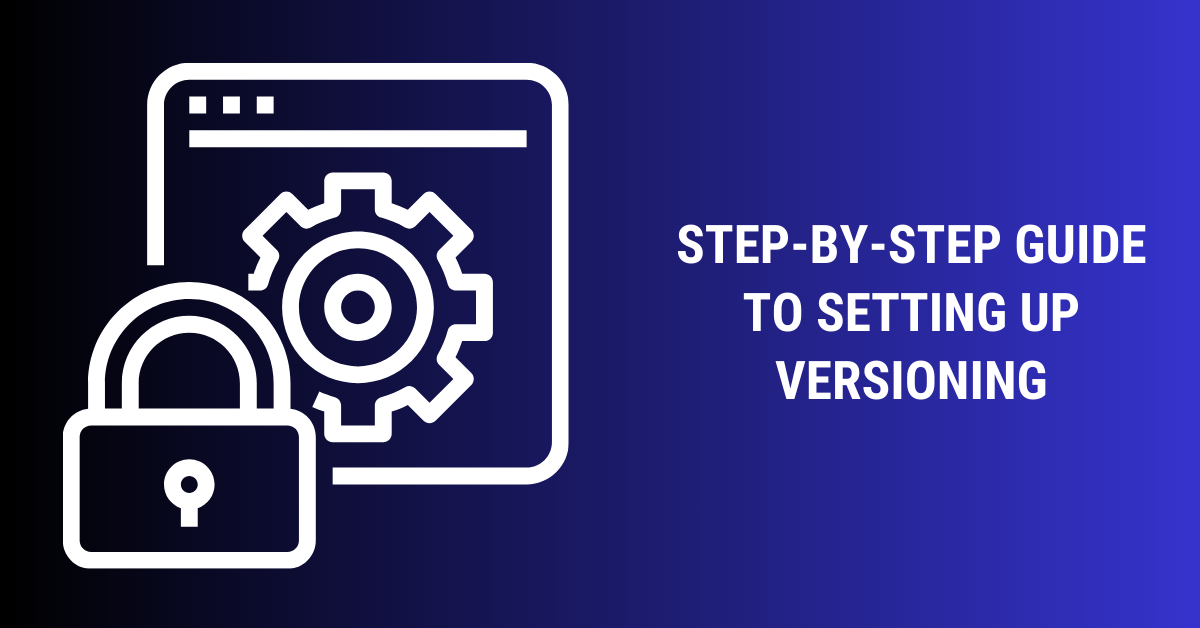To set up versioning for high-security data, you must use a secure data management system with built-in version control, enforce access controls, maintain logs, encrypt sensitive data, and regularly back up versions.
In today’s digital age, data security is of utmost importance. Protecting it from unauthorized access and accidental loss or corruption is crucial, whether it’s sensitive personal information or confidential company data. Implementing a robust versioning system is an effective way to enhance data security. We will delve into the importance of versioning in high-security data and provide a step-by-step guide on how to set it up.
Understanding the Importance of Versioning in High-Security Data

To fully appreciate the significance of versioning in high-security data, it is essential to understand what versioning means. In simple terms, versioning refers to creating and managing multiple iterations or versions of a document, file, or data set. Each version represents a snapshot of the data at a particular time, allowing workers to track changes, revert to earlier versions, and ensure data integrity.
What is Versioning?
Versioning is the repetition of keeping track of changes made to a document, file, or data set over time. It involves assigning a unique identifier to each version and storing metadata associated with the changes made. By maintaining a comprehensive history of modifications, versioning enables users to review and analyze the evolution of data, facilitating collaboration, auditing, and compliance.
For example, imagine a team of researchers working on a groundbreaking scientific study. As they make progress, they continuously update their research paper. With versioning, they can easily keep track of all the changes made through the writing process. This allows them to review and compare different versions, ensuring accuracy and consistency in their findings.
Moreover, versioning is not limited to text-based documents. It also applies to other types of data, such as software code. In software development, version control systems like Git are widely used to manage code changes. Developers can create branches, merge code, and roll back to previous versions if necessary, ensuring the stability and reliability of the software.
Why is Versioning Crucial for High-Security Data?
When dealing with high-security data, such as financial records, medical information, or intellectual property, versioning is critical in ensuring data integrity and maintaining accountability. By implementing a versioning system, organizations can closely monitor and control changes to sensitive data, reducing the risk of unauthorized alterations or malicious tampering.
Let’s consider a financial institution that handles sensitive customer data. With versioning, the institution can keep track of all changes made to financial records, ensuring that any modifications are authorized and properly documented. This not only helps in maintaining regulatory compliance but also strengthens the trust customers have in the institution’s data security practices.
Furthermore, versioning helps mitigate the impact of accidental errors or data corruption. In the event of a data breach or system failure, having access to previous versions allows organizations to quickly restore the data to a known good state, minimizing downtime and potential losses.
For instance, imagine a healthcare organization that stores medical records electronically. Suppose a software glitch corrupts some patient data. In that case, the organization can easily revert to a previous data version, ensuring that accurate and up-to-date information is available for patient care.
In conclusion, versioning is not just a technical practice but a crucial aspect of managing high-security data. It enables organizations to track changes, maintain data integrity, and ensure accountability. By implementing a robust versioning system, organizations can effectively protect their sensitive data and mitigate the risks associated with unauthorized access or data loss.
Preparing Your Data for Versioning
Before you can start implementing a versioning system, evaluate your current data security measures and identify the high-security data that require versioning.
Implementing a versioning system is an important step in ensuring the integrity and availability of your data. By keeping track of changes made to your data over time, you can easily revert to previous versions and have a clear audit trail of all modifications.
However, before diving into the implementation process, assessing your existing data security protocols and identifying any potential vulnerabilities or gaps in protection is essential. This evaluation should include an analysis of access controls, encryption mechanisms, and data backup procedures.
Access controls determine who can view, modify, or delete data. Evaluating your access controls involves examining user permissions, role-based access controls, and authentication mechanisms. It is important to ensure that only authorized individuals have access to penetrating data and access rights are properly enforced.
In addition to access controls, encryption mechanisms are another important aspect of data security. Encryption helps keep data from unauthorized access by converting it into an unreadable format. Evaluating your encryption mechanisms involves assessing the strength of encryption algorithms, key management practices, and the overall encryption infrastructure.
Data backup procedures are also critical for data security. Regularly backing up your data ensures you have copies of important information in case of data loss or corruption. Evaluating your data backup procedures involves examining the frequency of backups, the storage locations, and the restoration processes.
By understanding your current security posture, you can better determine how versioning fits your overall data protection strategy. It allows you to identify any weaknesses in your security measures that must be addressed before implementing a versioning system.
Evaluating Your Current Data Security Measures
Begin by assessing your existing data security protocols and identifying potential vulnerabilities or gaps in protection. This evaluation should include an analysis of access controls, encryption mechanisms, and data backup procedures. By understanding your current security posture, you can better determine how versioning fits your overall data protection strategy.
Access controls are an integral portion of data security. They define who can access, modify, or delete data within your organization. Evaluating your access controls involves reviewing user permissions, role-based access controls, and authentication instruments.
Ensuring that only approved individuals can access sensitive data is crucial for maintaining data secrecy. Role-based access controls allow you to assign specific permissions to different user roles, ensuring that employees only have access to the data necessary for their job responsibilities.
Verification mechanisms, such as passwords or biometric scans, confirm the identity of users before granting them access to data. Evaluating the strength and effectiveness of your authentication mechanisms is essential for preventing unauthorized access to your data.
Encryption mechanisms are another important aspect of data security. They protect data by converting it into an illegible format that can only be decrypted with the correct encryption key. Evaluating your encryption mechanisms involves assessing the strength of encryption algorithms, key management practices, and the overall encryption infrastructure.
Choosing strong encryption algorithms and implementing proper key management practices are crucial for ensuring the confidentiality and integrity of your data. Additionally, evaluating the overall encryption infrastructure helps identify any weaknesses or vulnerabilities.
Data backup procedures are essential for data protection. Regularly backing up your data ensures you have copies of important information in case of data loss or corruption. Evaluating your data backup procedures involves examining the frequency of backups, the storage locations, and the restoration processes.
Regular backups are necessary to minimize the risk of data loss. The frequency of backups should be determined based on the criticality of the data and the rate of change. Storage locations should be secure and separate from the primary data storage to protect against physical damage or theft.
A well-defined restoration process is crucial for recovering data in a disaster. Evaluating your restoration processes helps identify any gaps or inefficiencies that must be addressed to ensure a smooth and timely data recovery.
Identifying High-Security Data for Versioning
Next, identify the specific data sets that fall under the high-security category and require versioning. Consider data sensitivity, compliance requirements, and business impact in determining which data sets should enable version control.
Data sensitivity refers to the level of confidentiality and protection required for specific data sets. Highly sensitive data, such as normally identifiable information (PII) or financial records, may require stricter version control to ensure that any changes are properly tracked and audited.
Compliance requirements play a significant role in determining which data sets should have version control enabled. Industries such as healthcare and finance have strict data privacy and security principles. Identifying data sets that fall under these regulatory frameworks is crucial to ensure compliance and avoid potential penalties.
Business impact is another important factor when identifying high-security data for versioning. Data sets critical for business operations, such as customer databases or intellectual property, should enable version control to minimize the risk of data loss or corruption.
By focusing on high-security data, you can optimize resources and ensure that your versioning efforts are targeted effectively. This approach allows you to prioritize implementing versioning systems where it is most needed, providing more data protection for your organization.
Choosing the Right Versioning System
Once you have assessed your data security measures and identified the data sets for versioning, the next step is to choose a suitable versioning system that aligns with your organization’s needs and requirements.
Factors to Consider When Choosing a Versioning System
When evaluating various versioning systems, consider factors such as ease of use, scalability, integration capabilities with existing infrastructure, and security features. It is also essential to assess the support and maintenance provided by the system’s vendor and the costs associated with implementation and ongoing usage.
Review of Popular Versioning Systems
Several versioning systems are available in the market today, each with its own strengths and weaknesses. Some popular options include Git, Subversion, Mercurial, and Perforce. Research and compare these systems based on your necessities to determine which suits your organization’s needs best.
Step-by-Step Guide to Setting Up Versioning

Now that you have chosen the right versioning system, it’s time to dive into the setup process. Follow these steps to implement versioning for your high-security data successfully.
Initial Setup and Configuration
Begin by installing the versioning system on your chosen infrastructure. This may involve downloading the necessary software, configuring server settings, and establishing user accounts and permissions. Ensure that proper verification and authorization mechanisms are in place to restrict access to authorized personnel only.
Creating Your First Version
Once the system is set up, select the high-security data set you identified and create an initial version. This initial version will be the baseline or starting point for all subsequent changes and revisions. Document the necessary metadata, such as the date, time, and responsible party, to provide a clear audit trail of the versioning process.
Managing and Tracking Changes
As changes are made to the high-security data set, document and track each modification in the versioning system. Depending on the chosen system, this may involve committing changes, creating branches for parallel development, or merging changes from different contributors. Regularly review the change history and monitor for any unauthorized or suspicious activities.
Maintaining Your Versioning System
Setting up a versioning system is not a one-time task; it requires ongoing maintenance and monitoring to ensure its effectiveness and reliability.
Regular System Checks and Updates
Regularly perform system checks and updates to keep your versioning system secure and up to date. This includes applying patches and updates provided by the vendor, monitoring system logs for security events, and conducting periodic vulnerability assessments. By staying proactive, you can identify and address potential vulnerabilities before they are exploited.
Handling Version Conflicts
In a collaborative environment, conflicts can arise when multiple users simultaneously change the same data. As the administrator of the versioning system, it is essential to establish clear conflict resolution procedures and guide users on how to handle conflicts. This may involve manual intervention or automated conflict resolution tools the versioning system provides.
Backup and Recovery Strategies

Lastly, ensure that you have reliable backup and recovery strategies to protect against data loss. Regularly back up the versioning system and the high-security data it manages. Test the backup and recovery process periodically to validate its effectiveness and ensure that critical data can be restored during a disaster.
Key Takeaways
- Use data management systems like Git or SVN with robust version control features.
- Enforce strict access controls to determine who can make changes.
- Always maintain detailed logs of all changes made to the data.
- Use strong encryption methods for the data at rest and during transmission.
- Have regular backups of different data versions.
5 FAQs
Q: What is versioning in data security?
A: It’s the practice of keeping multiple versions of data to track changes and revert if necessary.
Q: Can I use GitHub for versioning high-security data?
A: While GitHub can manage versioning, for high-security data, consider a private, self-hosted solution with stricter access controls.
Q: How often should I back up my data?
A: The frequency depends on data importance and change frequency. For high-security data, daily backups or even more frequent might be recommended.
Q: Why is encryption important for versioned data?
A: Encryption ensures unauthorized parties can’t access or interpret the data.
Q: Who should have access to versioned data?
A: Only trusted individuals with a legitimate need to access or modify the data.
Conclusion
In conclusion, setting up versioning for high-security data is vital in enhancing security and protecting sensitive information. By understanding the importance of versioning, preparing your data, choosing the right system, following a step-by-step guide, and maintaining the system, you can establish a robust versioning framework that ensures the integrity and accountability of your high-security data.
